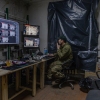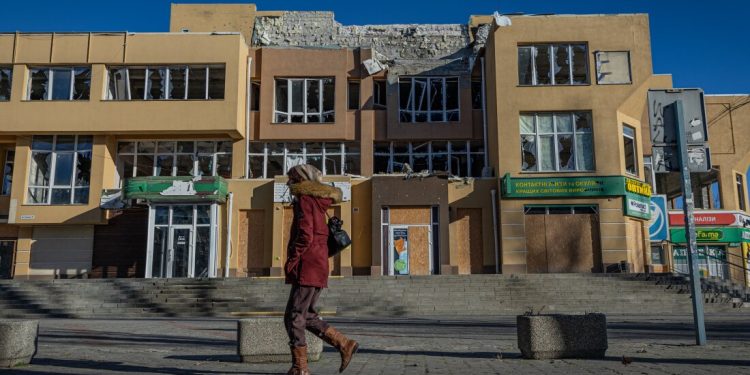
A woman walks past a war-ravaged shopping complex in Kherson, Ukraine, January 4. City residents say cloudless days are more dangerous as Russian drones take advantage of high visibility to fly over the frontline city.
Anton Shtuka for NPR
hide caption
toggle caption
Anton Shtuka for NPR
KHERSON, Ukraine — Russian military drones are swarming the skies over the border town of Kherson, carrying out deadly attacks that appear to target civilians, Ukrainian officials say.
“Since the first day of this year, the enemy has attacked the region (with drones) about 650 times,” said Oleksandr Prokudin, head of the Kherson regional military government. in an article on the social media app Telegram earlier this month. “Seven people died and 55 were injured as a result of these attacks.”
Not all Russian strikes target civilians, but on a recent trip to Kherson in southern Ukraine, on the banks of the Dnipro River, NPR found people terrified by the constant threat.

Danil Tatarinov, director of an Internet company in Kherson, shows small fragments of what he says is a cluster bomb that landed in his garden. Tatarinov’s field teams regularly face attacks from Russian drones and artillery.
Anton Shtuka for NPR
hide caption
toggle caption
Anton Shtuka for NPR
“I experienced it myself. Russian drones are constantly tracking us, it’s like a safari,” says Svitlana Budiukh, a 43-year-old resident who chose to stay in Kherson. “In summer we could hide under the green trees, but now in winter the leaves have fallen and we are more exposed.”

Budiukh said her husband was killed in Kherson when his car was hit by a Russian artillery shell. She described a terrifying existence in the city, where people try to go about their daily lives knowing that death could strike at any moment.
“Why am I staying? Because this is my city, these are my people,” she said.

Svitlana Budiukh, 43, volunteers in Kherson delivering food and other aid to people stuck in their homes because of the fighting. She suffered Russian drone attacks while making deliveries in her civilian vehicle. She says the danger is worse in winter, when the trees are bare and there are fewer places to hide.
Anton Shtuka for NPR
hide caption
toggle caption
Anton Shtuka for NPR
Budiukh spoke with NPR on a clear winter morning in a marketplace where elderly couples and families with children were shopping.

She and a friend, Natalia Savchenko, volunteer in Kherson, delivering food and other supplies to people trapped in their homes by the threat of Russia’s relentless attacks. They told NPR that drone strikes intensified last summer and are now seen by residents as a dark part of life.
“When this happens, you look for a place to hide,” Savchenko, 68, said. “We run under trees, in a shed or in a garage. God, we hide wherever we can find.”

A man walks down a street in the frontline city of Kherson, where traffic is blocked by anti-tank hedgehogs. The Dnipro River is visible in the background. This is the first line. Russian drone pilots and artillery teams operate from the opposite bank, with a clear view of neighborhoods that are home to at least 60,000 civilians.
Anton Shtuka for NPR
hide caption
toggle caption
Anton Shtuka for NPR
According to Savchenko, his son, a civilian worker, was hit by a Russian drone in September. “He threw a firebomb at her feet,” she said. “He was hospitalized for two months, his legs are seriously injured.”
A city liberated from Russia, now under siege
From the start of the full-scale Russian invasion in 2022, Kherson was a dangerous place. The city, once home to a quarter of a million people, was occupied by Russian soldiers until the Ukrainian army drove them out in November 2022.

Ukrainian flags honor the names of fallen Ukrainian soldiers in front of the administrative building in the regional city of Kherson.
Anton Shtuka for NPR
hide caption
toggle caption
Anton Shtuka for NPR
The Russians didn’t get far. Moscow’s forces still occupy the opposite bank of the Dnieper River, just a few kilometers away. They use artillery daily to bombard Kherson. Russian drone pilots are able to operate within sight of Kherson neighborhoods, which are still home to at least 60,000 people.

On January 6, a Russian drone hit a civilian bus in Kherson, killing one person and injuring nine others. January 12, A 57-year-old woman was hospitalized after a drone attack pelted her with shrapnel.
NPR was unable to confirm that Russian forces were deliberately killing civilians in Kherson, which would constitute a war crime under international law. Since Moscow launched its full-scale invasion in February 2022, the Kremlin has repeatedly denied targeting Ukraine’s civilian population.
But Ukrainian officials say they have overwhelming evidence that the attacks are intentional.

A cloud of smoke rises above Kherson after a new explosion. The city faces constant bombardment from Russian artillery as well as bombs dropped by drones.
Anton Shtuka for NPR
hide caption
toggle caption
Anton Shtuka for NPR
“The hunt continues”
Roman Kostenko, a Ukrainian MP from the Kherson region with close ties to the military, said he believed the attacks were an act of terrorism and also a form of target training.
“Russia uses (these attacks) to train its young pilots on Ukrainian civilians,” Kostenko said.
“They are chasing us even if it is clear that it is a woman, an elderly person or an emergency vehicle,” said Andrii Kovanyi, Kherson police spokesman. “Russian (soldiers) don’t hide it, they post it online on social media.”

Danil Tatarinov, director of a civilian Internet company in Kherson, with other company employees in the backyard of the company’s office. Despite what he describes as the “constant” threat of drones, Tatarinov’s teams still maintain internet connections for the city’s frontline residents.
Anton Shtuka for NPR
hide caption
toggle caption
Anton Shtuka for NPR
Residents of Kherson told NPR that this was one of the scariest aspects of the Russian drone attacks. After appearing to target civilians, Russian soldiers sometimes post videos and photographs online in which they brag about the violence.
“My own car was damaged in a drone attack,” said Danil Tatarinov, who runs an Internet company in Kherson. “I found a video of it on Russian social media.”

Danil Tatarinov claims that a video released by Russian soldiers on the messaging app Telegram shows a drone attack on his civilian car, shown in this image. Tatarinov escaped without injury but his car was damaged by shrapnel. The message included in the Russian video: “The hunt continues.”
Telegram video
hide caption
toggle caption
Telegram video
He said the video, which appears to have been filmed from the perspective of a drone, shows a grenade being dropped on his civilian car. The attack narrowly missed, causing no injuries, while damaging the rear bumper with shrapnel. NPR was unable to verify the origin or content of the video.
Shaking her head, Tatarinov read the video’s caption, written in Russian: “No luck this time,” it read. “But the hunt continues.”

Ukrainian flag stripes on Danil Tatarinov’s civilian car, which he says was damaged by a Russian drone strike.
Anton Shtuka for NPR
hide caption
toggle caption
Anton Shtuka for NPR
NPR field producer Polina Lytvynova contributed reporting to this story.


